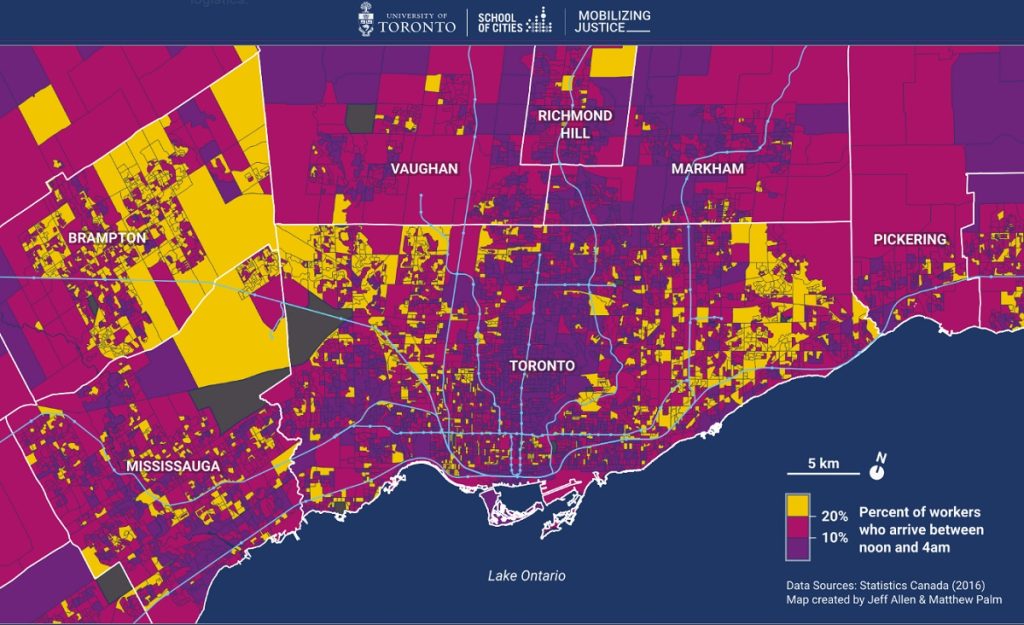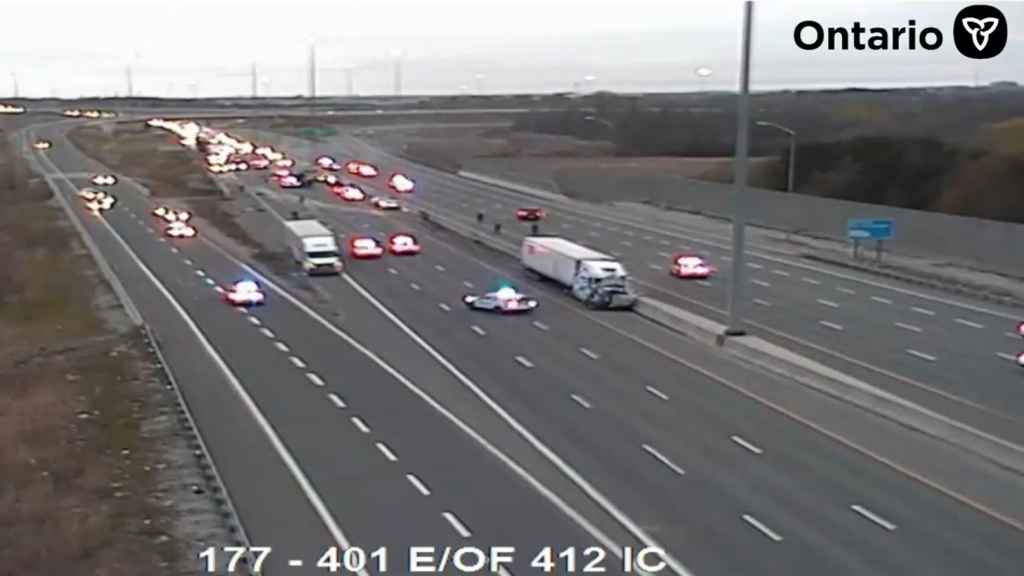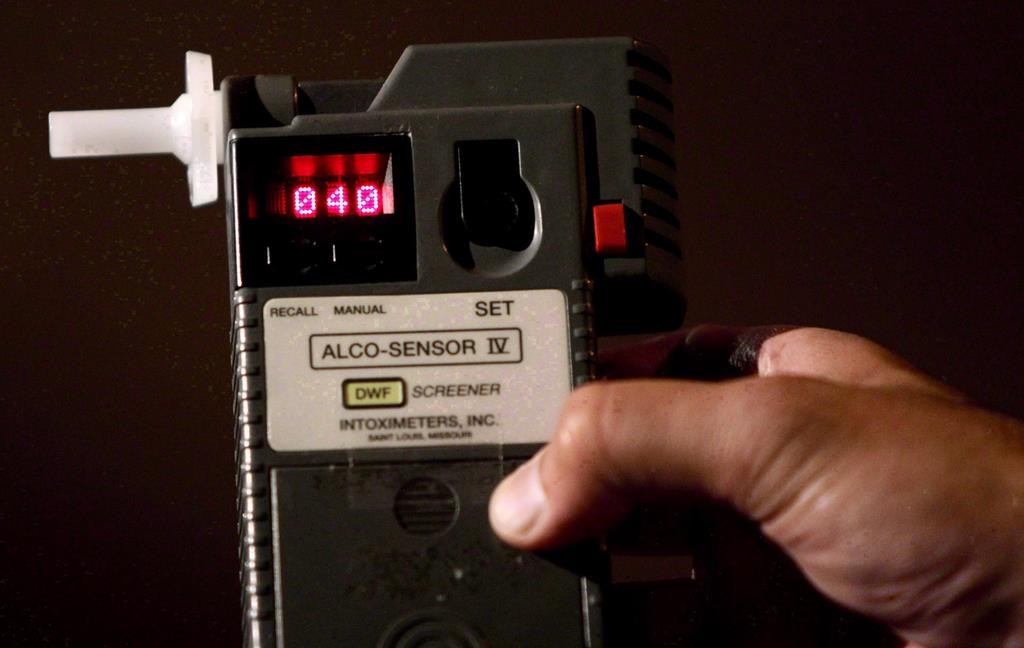Toronto-area shift workers need ‘transportation justice,’ better service: study
Posted November 19, 2023 9:44 am.
Last Updated November 19, 2023 10:57 am.
A new study out of the University of Toronto is taking a closer look at where evening and night shift workers live in Canada’s biggest cities and researchers say more needs to be done to help commuters realize “transportation justice.”
The study, carried out by the University of Toronto School of Cities and the research organization Mobilizing Justice, used long-form 2016 Census data to try to map out where shift workers live. They were able to broadly determine where people most went to work between 12 p.m. and 4 a.m. Researchers also worked to overlay that information with other datasets to try to see where gaps exist and to better understand travel patterns.
In the Greater Toronto Area, researchers found larger concentrations of shift workers in east Brampton and northeast Mississauga along with parts of northwest and east Toronto. Generally speaking, the study showed evening and night shift workers have lower incomes. It also showed Black, Filipino, South Asian, and Indigenous people work those shifts in greater numbers as did newer immigrants to Canada.
Matthew Palm, an assistant professor at the University of North Carolina and a former GTA resident was the study’s lead author. He said one thing is clear about the current system: It doesn’t meet contemporary needs.
“The public transit system in the GTA is really designed to serve peak-hour workers because of course it was developed … decades ago when most people worked nine-to-five jobs, and of course, we’re now transitioning into a 24-hour economy where people need to be at work sites at all hours,” he told CityNews in a recent interview before citing the areas where higher concentrations of evening and night shift workers were found to live and/or work.
“What that means is those are residents who are trying to get to work at a time of day when transit service isn’t as good, but who are also navigating other challenges.”
RELATED: TTC rolling out new Line 3 Scarborough RT bus replacement plan
CityNews visited the areas cited in the study after 12 a.m. on Friday to see what riders face on a typical weekday overnight.
At The Gore Road and Queen Street East near Highway 427 just before 12:30 a.m., Brampton Transit’s last westbound 501 Züm Queen bus was standing room only as several passengers got on and off. There were no eastbound buses at that point. Local transit service close to major businesses such as Amazon and Stellantis wrapped up not long after. Brampton operates a couple of local routes throughout the overnight period.
Palm highlighted Toronto Pearson International Airport in Mississauga and the surrounding area as a major destination for evening and night shift workers, similar to other major airport hubs. Brampton Transit’s 115 Airport Express bus to the airport from Bramalea City Centre terminal finished just after 1 a.m., leaving a four-hour gap.
At Bramalea Road and Derry Road East, the last local MiWay (Mississauga’s transit agency) bus rolled by at around 2:15 a.m. and the next one wasn’t expected for a couple of hours. However, the service has five 24-hour routes – two on Hurontario Street, one on Dundas Street, one on Bloor Street West, and one between Mississauga City Centre and the airport. Head over to Westwood Square Mall in Malton, passengers began lining up before 4 a.m. to catch the first local MiWay bus of the day. As the bus pulled in, several passengers could be seen getting off.
Toronto is a bit of a different case. The TTC operates a vast 24-hour network. During the overnights, the TTC’s “Blue Night Network” kicks in and bridges the gap between when subway service and local bus routes start and stop. There are more than two dozen routes and three go to airport passenger terminals.
Palm praised the TTC’s long-time overnight network and said certain cities in the United States are starting to build out networks that are similar. He also noted there have been improvements in recent years for MiWay and Brampton Transit. However, he said transit in the GTA needs a rethink.
“Providing transit service in the off-peak is a matter of equity and is a matter of justice,” Palm said.
“If equitably serving people from all walks of life is something we want to make sure we’re doing in our city services and things like transit, then making some investments to support shift workers is a step towards that equity goal because so many newcomers and people with low incomes are working at these times of day and are over-represented at that time.”
Researchers have tried to reinforce the plight of evening and night shift workers through the study and mapping, but it only provides a partial glimpse.

Palm said the aggregated data isn’t enough to help with all the planning that’s needed to boost services. He said it might mean partnering with employers to gather information to help carve out schedules.
“We need better data on different parts of the off-peak week: early evening, late evening, the early part of the night, the early morning,” he said.
When it comes to evening and night transit services, Palm said it’s not just shift workers. He noted there has been a post-COVID surge of remote workers who are going out more.
“They were spending time commuting at 5 p.m. Now they’ve got extra time to do things and they’re going out at night,” he said.
“The stars have kind of aligned to create a situation where planners are having to think more strategically about how do we provide high-quality transportation services to people at all times of day.”
RELATED: What if public transit was like Uber? A small city ended its bus service to find out
Given the vast size of Toronto and the surrounding regions, Palm acknowledged the cost factors of increasing bus services.
“When you’re thinking about allocating service, you’re allocating it in blocks of three to four hours of time because that’s how long your bus drivers can work before … they need to take substantial time off and to what extent can we align transit service with those schedules,” he said.
Palm said a solution could lie in on-demand transit services similar to ridesharing services like Uber and Lyft, but instead it would be buses or smaller transit vehicles showing up.
“These are also advantageous because at night we don’t want the shift workers waiting around a long time for a bus because of safety reasons,” he said.
Better access to cycling infrastructure, more sidewalks and better lighting to help with safety are measures Palm said should also be considered as part of a suite of transportation upgrades.
As municipalities in the Greater Toronto Area begin or continue budget planning for 2024 and beyond, he said this reality remains for those who use transit during off-peak periods.
“It’s still too many riders and too many residents who are stuck driving who would rather not be. It doesn’t feel like enough because we are playing catch up,” Palm said.
What are transit agencies doing in response?
CityNews contacted the City of Mississauga, the City of Brampton and the Toronto Transit Commission to ask about the study and potential plans for the future to address the issues highlighted by the study and researchers.
MiWay
A City of Mississauga spokesperson told CityNews the transit agency has seen observations reflected in the study, adding consideration is being given to boosting service..
“We have seen an increase in ridership on routes that serve major shift work employment areas and this study further confirms the unique travel patterns and needs of this segment of the workforce. MiWay is committed to improving service with any available resources that we have to best align with demand throughout the city,” Irene McCutcheon wrote.
“As demand increases for overnight service throughout Mississauga, more routes will be added to the 24-hour network to align with that demand.”
She said the municipality is currently studying the feasibility of creating on-demand transit.
McCutcheon also noted MiWay has seen ridership that surpassed levels before the COVID-19 pandemic.
“Any increase in service to this point has been used to respond to overcrowded buses where customers are being left behind on the existing network,” she wrote.
TTC
Toronto Transit Commission spokesperson Stuart Green said the study is helpful for the agency.
“We appreciate these types of reports to help us advocate for sustained and expanded transit funding. Unfortunately, when operating subsidies are in jeopardy, these are the services that are often challenged since buses and streetcars are not “full” when they operate and therefore seen as ‘inefficient,'” he wrote in a statement to CityNews
When it comes to the Blue Night Network, he said it aims to “maximize access” to people and businesses within a 15-minute walk. He said the transit agency lowered wait times on Jane Street, Finch Avenue and Wilson Avenue to 20 minutes from 30 minutes earlier in 2023. Other routes still operate on half-hour intervals. Green said the Finch Avenue buses were changed because staff saw a demand for connections to Brampton Transit at Humber College.
As for service levels, Green said those are regularly reviewed to make adjustments as needed.
He said the TTC is going to start, on a pilot project basis, rolling out new or additional overnight streetcar service in 2024, but the measure is also being done to “mitigate temporary streetcar storage constraints” as the fleet of streetcars expands.
Meanwhile, Green said the agency is currently in the midst of a public five-year service review to see where improvements should be made. For those interested in participating, click here to access the survey.
Brampton Transit
A spokesperson for the City of Brampton acknowledged a request for comment Friday morning, but a response wasn’t received as of the time of publication. This story will be updated if a response is received.










